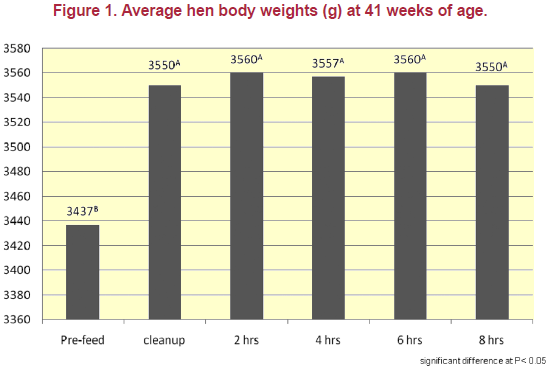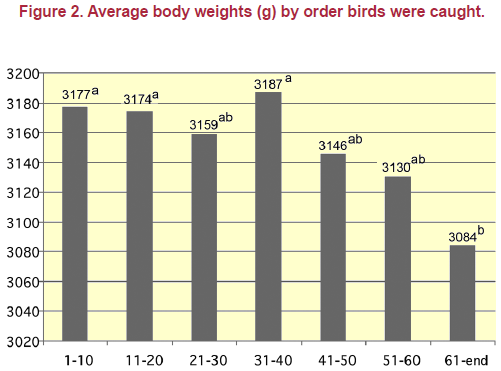



Weighing Broiler Breeder Females Post-Feeding
By R. Keith Bramwell, Jon R. Moyle, Doug E. Yoho and Bob S. Harper, University of Arkansas, Division of Agriculture. Published in Avian Advice, Spring 2008, Volume 10, No. 1. The conclusions have important implications for both the timing of weighing and how many birds to weigh for optimum breeder flock management.Introduction
Obtaining accurate body weights is a critical part of the process of rearing replacement broiler breeder pullets and managing breeder hens and males. From the first few weeks of age in the pullet house, all feed allocations are determined by the bird’s weekly weight gains. Obtaining accurate body weights is very important to maintaining uniformity, body conformation and the overall development of pullets and young cockerels. Research has shown that accurately and uniformly controlling body weight of both replacement breeders and breeders in the hen house will result in improved performance parameters.
| More on the First Author | |
| R.K. Bramwell Extension Reproductive Physiologist |
|
In the United States, the majority of poultry integrators rear pullets on some version of a skip-a-day feed program in order to control body weight among all the birds in a house. Under our current housing conditions, skip-a-day feed programs are the best way to uniformly distribute feed to all birds simultaneously in an effort to maintain body weight uniformity. However, the presence of feed in the crop or digestive tract will inflate the actual body weight of the birds and skew feed allotments. Therefore, replacement breeders are typically weighed on off-feed days to normalize the data and not confound body weights with either the presence or absence of feed in the crop or digestive tract. This allows for body weight measurements to be consistent from week to week without regard for feed clean up time and the presence or absence of feed in the crop. Therefore, each week pullets and cockerels are weighed with an empty crop and digestive tract. This process continues until birds are moved to the hen house and feeding begins on an everyday basis. These weights are considered to be ‘empty’ weights.
In the hen house, most commercial producers move from a skip-a-day to an everyday feed program as hens are brought into production. Feed is often provided daily in the early morning hours shortly after the lights are turned on. While feeding hens everyday in the hen house has proven to be an effective management tool, birds cannot be weighed on ‘off feed’ days. This has led to the concern over whether hen weights are truly reflective of the actually body weight and mass. Consequently, current industry recommendations are designed to address this issue and suggest producers weigh breeders late in the afternoon hours to obtain the ‘empty’ weights. This allows any feed consumed to have time to pass through the birds digestive system and therefore create an ‘empty’ weight situation for weighing purposes. In breeders this can be further complicated by the fact that the majority of egg production occurs in the morning hours following feed cleanup which would result in additionally body weight loss.
To address this issue, a research project was designed to weigh breeders at various intervals during the day to determine the best time to weigh birds to most accurately reflect actual body weight gains.
When To Weigh Breeders
Birds used in this study were housed at the University of Arkansas Broiler Breeder Research Farm. A single pen of breeders containing 71 hens was used for this study and during each weigh period, all hens were corralled in a catch pen with each hen weighed individually so that no sampling error could affect the results. All hens were weighed prior to daily feeding and again at feed clean-up time. Additional bird weights were obtained at 2, 4, 6, 8 and 10 hours following feed clean-up. This process took place on the same birds at 24, 28, 34 and 41 weeks of age. These age periods represented pre-laying, pre-peak, peak and post-peak in production stages of life.
Weight data from the 41 week old birds are displayed in Figure 1 and show no significant differences in body weight at any time period after feed clean-up through 10 hours after feed is consumed. Data from each of the other ages (24, 28 and 34 weeks of age) reflect the same patterns and trends with no significant differences detected between time intervals following feed clean-up time. It was previously believed that hens would lose body weight throughout the day to approach the ‘empty’ weights found prior to feeding. However, these data make it apparent that the passing of feed and the consumption of water appear to offset each other and allow the hen to maintain a near constant body weight through 10 hours following feed clean-up. Body weights obtained prior to feeding would be the only weights that could be considered ‘empty’ weights as they were obtained immediately after lights came on in the morning and are a reflection of body weight loss due to feed and water passage occurring during the dark hours.
These results would allow breeder service technicians to weigh breeders in the hen house at any time following feed cleanup and that the data would be consistent with body weights obtained at any time throughout the day. These data will allow technicians to be more productive in a given day in regards to scheduling weighing of breeders in the hen house.

How to Weigh Birds
When weighing birds, it is often recommended to weigh all birds caught in a catch pen and not weigh a specific number of birds to meet a given criterion. This has been the recommendation for broilers in research trials but has not been evaluated in replacement pullets and breeders. As part of this project, body weights were recorded for each hen in the order they were caught in the catch pen. For each age group and for each time interval previously mentioned, this resulted in 40 incidences of weighing all birds in a catch pen. Data presented in Figure 2 is a summary of all the data obtained from this project and shows that the last birds caught in a catch pen are significantly lighter weight than the first birds caught. This data supports that found with broilers in research trials and demonstrates the importance of weighing all birds in a catch pen.
For instance, if 60 birds are caught in a catch pen and only the first 50 are weighed because that meets the minimum number needed, then the body weight recorded would not be reflective of the actual weight of the birds caught or the birds in the flock. If this occurs with pullets and feed allotments are determined based upon these body weights, then inaccurate feed allotments could be provided and less control over flock body weight would be the result.

Summary
- When weighing broiler breeders in the hen house, accurate and consistent body weights can be achieved by weighing birds at any time after feed clean-up. There is no advantage to waiting for feed passage in an attempt to obtain ‘empty’ weights in breeders during the afternoon hours.
- When weighing birds caught in catch pens, it is important to weigh all birds caught in the pen and not stop at a predetermined number of birds. The last birds caught will be the smallest birds and need to be included in the final group weight to most accurately determine the average body weight of the birds in a flock.
August 2008








